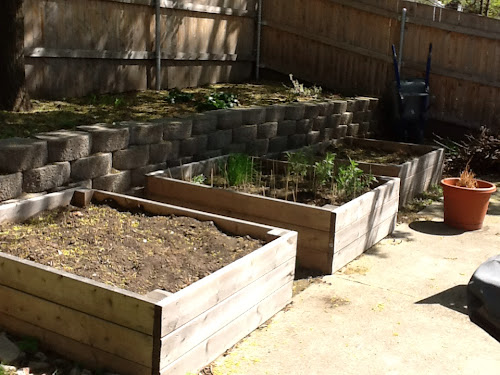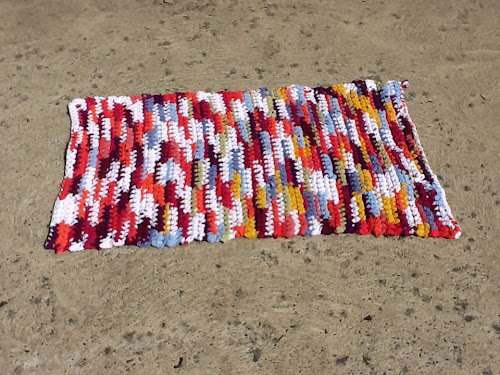Wednesday, April 25, 2012
Open the Windows and Let in the World!
At the same time, warm spring weather draws us all out of our houses again. Given the scarcity of large backyards in my neighborhood, many of my neighbors garden in their little front yards and our children all play on the sidewalks (the older ones in the street itself). The moms discuss dinner plans in the afternoon, and the little old lady across the street enjoys her role as neighborhood grandma. At 90 she'll sit on the ground with my daughter Alessia to play with leaves and little rocks.
We're very lucky to have landed in this neighborhood, and I am especially reminded of that in spring.
Tuesday, April 17, 2012
Urban Garden Challenges - shade, roots, and a cat
Across my back yard is a patch of dirt about five feet deep and twenty feet wide between my patio and a wall. When we moved in it was quite literally just a patch of dirt. Nothing grew there. The first year we tried to grow vegetables. The dirt was so poor, the tree roots from the maples that run across the back of the property so invasive, and the shade from the same trees so intense that we had very little luck. Last year, we put in three raised beds. This eliminated the problems of the roots and the poor soil, but not the shade problem. The perennial herbs, including sage, thyme, tarragon, chives, and oregano, did alright. The beans were pretty sad until they finally got high enough to find a little sun. The eggplant was a complete failure. Although that had as much to do with the squirrels as the other problems.
This year I had planned on growing some spring vegetables before the leaves came out on the maples and then annual shade flowers. The perennial herbs all came back, and my plan was to leave them for at least another season. Based on that plan I went out early last week with my little trowel and some seeds, very excited to have a few minutes to myself in the garden. The first dissapointment came when I realized how many tree roots had already invaded the beds. We expected this to happen eventually, just not after one season. The second, much bigger dissapointment came when I realized that my cat had spent the winter using all three beds as litter boxes. That's right. All three beds are full of cat poop, and, since I am pregnant, that means I really shouldn't garden there at all this season.
After a good cry (pregnancy hormones, a couple of sleepless nights with a sick baby, and this type of dissapointment are not a good mix), I started to think of alternate plans. For this summer, we are going to put shade-tolerant annual flowers in the beds. To be more specific, Adam is going to be putting flowers in there. The big question will be what we should do next year and in the following years. I see, at the moment, three options:
One, leave the beds as is and continue to grow flowers. Flowers care less about the roots than edibles, and there are many shade-tolerant flowers to choose from. This is the least labor-intensive option. It is also my least favorite option, because, as much as I love flowers, I am much more interested in growing edibles. Adam is the more passionate flower gardener.
Two, remove the raised beds, install an underground barrier between the beds and the trees, rebuild the beds. This is the most labor intensive option, and honestly I have doubts about the long-term effectiveness of the barriers. It seems to me that the roots would eventually find their way under the barriers and back up again anyway.
Three, remove the beds and replace them with a bunch of containers. This would eliminate the root problem entirely. We could plant perennial flowers in some of the pots and use others for early spring edibles followed by warm weather annuals. At least one of the raised beds could be moved to the front yard. The other two could be given away or used for other purposes, like coralling compost.
After discussing all this with Adam, it seems like we are going for option one. It is the easiest, and with baby number two coming in June that is an important consideration. In the next couple of years we will add raised beds to the tiny little front and side yards in order to grow more vegetables. The back will remain dedicated to flowers.
PS A few days after writing this, I took a closer look at the middle bed and realized that the cat hadn't completely befouled it. Yet. You will notice the bamboo skewers sticking out of the dirt all around the plants. I am hoping this will keep the cat out.
Sunday, April 15, 2012
Scrap Rug
This is my first true scrap project. When putting away my regular clothes and pulling out my pregnancy clothes, I realized that I had a large collection of t-shirts with small holes in them. For several years, I had been shoving old t-shirts to the back of my drawer. Once I added a few of my husband Adam's old, beat up undershirts, I had quite an impressive collection. I went online and started looking for project ideas.
In the end I decided on making a crocheted rag rug, using directions found on Crazy Mom Quilts. Our bath mats are pretty old and worn. For awhile my husband has been talking about wanting a new one, but it seems such a silly thing to spend money on. The old ones mght be worn looking, but they are still doing their job of absorbing water from my feet when I get out of the tub, right? So this project seemed perfect. I reclaimed space in my drawers without throwing out those t-shirts, I had a project to work on, and we got a new bath mat.
I cut the bodies of the shirts into half inch loops and threw them all into a pillowcase. The planner in me thought about working out a pattern, but in the end I decided that I was over planning this one. So I mixed up all the diffent loops in the bag, and just pulled them out randomly. It has been a great project for picking up at odd moments. Chores are done, and Alessia is still napping. Alessia is in bed for the night, and I feel like sitting for a few moments with something relatively mindless to do with my hands. Those sorts of odd moments. Once all the loops were used up, I wrapped the ends in white to reinforce them and add a bit of a finished look, sewed down the ends at the beginning and the end, and threw it in the washer.
I'm so happy with how it came out. Now I have a pile of sleeves from all those t-shirts. I think I'm going to do a little looking around for a project.
Monday, April 9, 2012
The Weekday Vegetarian 2 - with a recipe
This is one of my favorite quick pasta meals. It's an all-in-one meal, and the sauce can be made in advance so that all you have to do is cook the pasta in the evening.
Pasta e Ceci (Pasta with Chick Peas) - serves four
Ingredients
Olive oil
Large onion, diced
Two bell peppers (red and/or green depending on your preference and the price), diced
Large can of chopped tomatoes or one box of Pomi chopped tomatoes
2 small cans of chick peas, rinsed, or 4 cups of cooked chick peas
Oregano to taste
Hot pepper flakes to taste
Salt and back pepper to taste
Pasta - 12 ounces for 4 people, rotini, medium shells, and cellentani are all good choices
Method
Saute the onion in olive oil until translucent. Add the peppers and saute until they start to soften. Add the tomatoes, oregano, salt, black pepper, and pepper flakes. Simmer until the peppers are done. Add the chick peas and heat through. Adjust the seasonings. If you find the sauce to be too thin, you can add a small can of tomato sauce or a few tablespoons of tomato paste before the vegetables are completely cooked. If you find the sauce to be too thick, add a small amount of the pasta cooking water. Sometimes I add sliced mushrooms to this sauce, sauteing them after the onions.
Boil the pasta in plenty of salted water. Mix the sauce and pasta. Serve with grated pecorino or parmesan. You can also serve this with feta cheese crumbled on top. This option is especially appealing if you are used to eating meat with every meal! as the feta adds a richer taste to the dish. While this works as a one-dish dinner, a salad or green vegetable like broccoli is nice too.
Monday, April 2, 2012
The Weekday Vegetarian - with recipes
After my last post on eating naturally raised, local meat, a friend commented that she would like to eat more naturally raised meat, but it was expensive for her family. Then she added - maybe if I had more vegetarian options to balance it. Yes! That is exactly how we handle it. Naturally raised meat fits in my budget, because we don't eat it every day.
While Mark Bittman has his "vegan before 6:00" approach, our approach could be called "the weekday vegetarian." It's not a strict rule. With this current pregnancy, my protein needs have been incredibly high leading to the occasional weeknight meat meal, and every now and then we eat fish or seafood during the week. For the most part, though, we are vegetarians five to six days out of seven.
My plan then is to post some vegetarian, weeknight recipes. The first is more of a method than a single recipe.
Beans and Greens Over Pasta (for two, easily doubled or tripled)
Ingredients
Olive oil
Small clove garlic
2 cups (or one small can, rinsed) cooked beans (my preference is cannelini or chick peas)
1 large bunch of greens (kale, chard, spinach, broccoli, and broccoli rabe are all favorites)
Salt
2-3 ounces of pasta per person, rotini, penne, and medium shells work well
Grated pecorino and/or parmesan cheese
Method
If you are using kale or chard, strip the leaves off the tough center rib, chop into bite size pieces, boil, and drain. If you are using broccoli, spinach, or broccoli rabe, you don't need to precook them. Heat a couple of tablespoons of olive oil in a medium saucepan. Saute the garlic. If you are using kale or chard, add the greens and the beans and heat through. If you are using broccoli, broccoli rabe, or spinach, add them to the oil and garlic and saute briefly. Add a little water and cover the pan to allow the vegetables to simmer. When the vegetables are tender, add the beans and heat through. If you are using beans cooked from dry beans, add salt to taste. If you are using canned beans, you may not need to add salt.
In the meantime, boil water and cook the pasta. Add it to the cooking pan. If the mixture seems very dry, you can add a little of the pasta water or a little extra olive oil. Add grated cheese and salt and pepper to taste. Serve with additional cheese.
You can prepare the sauce in advance and then heat through right before adding the pasta and serving.
This can be a one-dish meal. It can also be served with any sort of salad. In the summer I love a fresh tomato salad with this.

